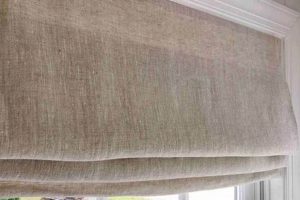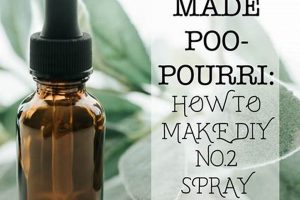A do-it-yourself enrichment toy designed for pets, primarily dogs, consists of fabric strips attached to a base. The fabric strips create a textured surface where small food items or treats can be hidden. The animal then uses its sense of smell to locate the hidden rewards, stimulating its natural foraging instincts.
This type of activity promotes mental stimulation and slows down eating, which can aid in digestion and prevent bloating. The object’s origins lie in the broader category of canine enrichment, which aims to provide pets with activities that mimic natural behaviors and reduce boredom and anxiety. The design allows owners to customize the level of difficulty, making it suitable for a range of animals with differing foraging abilities.
The construction of such an item involves several considerations, including material selection for safety and durability, the method of attaching the fabric strips to the base, and the desired level of challenge for the pet. Further discussion will elaborate on these aspects, providing guidance on constructing an effective and safe enrichment device.
Construction Recommendations
Effective design and construction require attention to detail to ensure both safety and optimal functionality for the animal.
Tip 1: Material Selection: Choose non-toxic, durable fabrics such as fleece or cotton. Avoid materials with small parts that could be ingested, posing a choking hazard.
Tip 2: Base Stability: Utilize a sturdy base, such as a rubber mat or tightly woven fabric, to prevent slippage during use. Reinforce the edges of the base to prevent fraying.
Tip 3: Fabric Strip Length: Cut fabric strips of varying lengths to create diverse levels of difficulty for foraging. Shorter strips offer less concealment, while longer strips provide a greater challenge.
Tip 4: Attachment Technique: Securely attach the fabric strips to the base using durable knots or stitching. Ensure that the attachments are firm and cannot be easily dislodged by the animal.
Tip 5: Color Contrast: Employ a range of colors to enhance visual stimulation for the animal. Contrasting colors can make the foraging process more engaging.
Tip 6: Size Considerations: Adjust the overall dimensions to suit the size and breed of the animal. Smaller animals require smaller dimensions, while larger animals may benefit from a larger, more expansive design.
Tip 7: Gradual Introduction: Introduce the item to the animal gradually, initially placing treats on top of the fabric strips. Gradually increase the difficulty by concealing the treats deeper within the fabric.
By adhering to these recommendations, a safe and stimulating enrichment item can be crafted. The thoughtful selection of materials and construction techniques will contribute to the longevity and effectiveness of the device.
The subsequent section will address cleaning and maintenance procedures to ensure continued safety and hygiene.
1. Material Non-Toxicity
The selection of materials is paramount in the construction of a foraging enrichment device. Material non-toxicity directly impacts the safety of the animal utilizing the device. The act of foraging involves oral exploration; therefore, the potential for ingestion of small fibers or components exists. Consequently, the use of materials containing harmful dyes, chemicals, or small, detachable parts presents a tangible risk to the animal’s health. A failure to prioritize non-toxic materials can lead to gastrointestinal distress, allergic reactions, or even more severe complications if ingested.
For instance, using synthetic fabrics treated with formaldehyde or containing heavy metals can lead to chronic health issues upon prolonged exposure through oral contact. Similarly, embellishments such as buttons, beads, or easily detached plastic components pose a choking hazard. In contrast, the utilization of natural fibers like untreated cotton or fleece, devoid of potentially harmful chemicals, minimizes the risk of adverse health effects. The meticulous selection of materials thus functions as a crucial preventative measure against potential harm.
In conclusion, prioritizing material non-toxicity is not merely a precautionary measure but a fundamental requirement in the construction of these enrichment items. This requirement stems from the inherent risk of ingestion during foraging activities and the potential for adverse health consequences arising from exposure to harmful substances. The conscious selection of safe materials ensures the device serves its intended purpose of providing enrichment without compromising the animal’s well-being.
2. Construction Durability
Construction durability is a critical factor influencing the long-term utility and safety of foraging enrichment devices. The degree to which the object withstands repeated use and interaction directly impacts its value as an enrichment tool and the potential for hazards to the animal.
- Base Material Integrity
The base material of the object provides the foundation to which the fabric strips are attached. A weak or easily damaged base compromises the entire structure. For example, a thin fabric base may tear under the repeated pulling and pawing of the animal, leading to detached fabric strips that can be ingested. A more durable base, such as heavy-duty rubber or tightly woven canvas, provides a stable and resilient platform, extending the lifespan of the object.
- Attachment Security
The method of attaching the fabric strips to the base significantly contributes to overall durability. Insecure attachments, such as loosely tied knots or weak stitching, will fail under stress, leading to detachment of the fabric. Stronger attachment methods, including reinforced stitching or tightly secured knots with durable materials, ensure the fabric strips remain firmly connected to the base despite vigorous use.
- Material Resistance to Wear
The properties of the fabric strips themselves influence the device’s longevity. Fabrics prone to tearing or fraying will deteriorate rapidly with repeated use, reducing the item’s effectiveness and increasing the risk of ingestion of loose fibers. Selecting durable fabrics like fleece or tightly woven cotton, resistant to tearing and fraying, maintains the integrity of the object over time.
- Resistance to Moisture and Cleaning
These items are often exposed to saliva, food particles, and other contaminants, necessitating regular cleaning. Construction methods and materials that are susceptible to degradation from moisture or washing will shorten the lifespan of the item. Using water-resistant base materials and durable stitching that can withstand repeated washing cycles ensures the device remains hygienic and functional over an extended per
iod.
The factors outlined above collectively determine the construction durability of a foraging enrichment device. Careful consideration of base material integrity, attachment security, material resistance to wear, and resistance to moisture and cleaning is essential to creating a durable, safe, and effective enrichment tool for animals.
3. Hygiene Maintenance
Hygiene maintenance is a critical, often overlooked, component in the responsible use of fabric-based enrichment items. The structure of these items, with their multiple fabric strips and crevices, readily accumulates food particles, saliva, and other organic matter. This accumulation creates an ideal environment for bacterial and fungal growth. The failure to adequately clean these devices can lead to a variety of adverse health effects for the animal, including gastrointestinal upset, skin infections around the mouth and nose, and the spread of harmful pathogens.
Regular cleaning routines should be implemented to mitigate these risks. These routines involve several key steps. First, removing all visible food debris immediately after each use prevents the build-up of organic matter. Second, periodic washing of the entire item in hot, soapy water eliminates accumulated bacteria and fungi. The frequency of washing depends on the intensity of use, but a minimum of once per week is recommended for regularly used items. Third, thorough drying of the device after washing prevents the growth of mold and mildew. Air drying in direct sunlight is preferred, as sunlight has natural disinfecting properties. The specific type of detergent used should be carefully considered; hypoallergenic, fragrance-free detergents are recommended to minimize the risk of skin irritation or allergic reactions in the animal.
In summary, diligent hygiene maintenance is not an optional addendum, but an essential aspect of responsible usage. Neglecting these protocols can transform a beneficial enrichment tool into a potential source of harm. The implementation of regular cleaning routines, including the removal of debris, periodic washing, and thorough drying, ensures that fabric enrichment items remain a safe and hygienic source of stimulation for animals. This proactive approach safeguards animal health and maximizes the long-term benefits of this enrichment strategy.
4. Stimulation Level
The stimulation level provided by a foraging enrichment device is a critical design consideration. This parameter determines the extent to which the item effectively engages the animal’s cognitive abilities and natural foraging instincts. An inappropriately designed item may prove either too challenging, leading to frustration and abandonment, or too simplistic, resulting in boredom and a lack of enrichment.
- Density of Fabric Strips
The density of fabric strips on the base directly impacts the difficulty of locating hidden food. A higher density of strips provides more concealment, requiring the animal to engage its olfactory senses and problem-solving skills to a greater extent. Conversely, a lower density offers less concealment, making the task easier and potentially less stimulating. The appropriate density depends on the animal’s experience with foraging enrichment and its cognitive abilities.
- Length Variation of Fabric Strips
Varying the length of the fabric strips introduces another dimension of complexity. Shorter strips offer minimal concealment, while longer strips create deeper hiding places. The inclusion of both short and long strips requires the animal to adapt its search strategy and explore different levels of concealment. This variation maintains engagement and prevents the animal from becoming accustomed to a single search pattern.
- Food Item Placement Complexity
The manner in which food items are placed within the device influences the challenge presented to the animal. Simply scattering treats on top of the fabric strips provides minimal stimulation. Hiding treats deep within the folds of the fabric, or even partially burying them, increases the cognitive demand of the task. Varying the placement of food items in each use session prevents the animal from learning a fixed search pattern and encourages continued exploration.
- Scent Introduction
Introducing novel scents to the device can further enhance the stimulation level. Applying small amounts of animal-safe essential oils or other natural scents to the fabric strips can pique the animal’s interest and encourage exploration. The introduction of new scents provides olfactory enrichment and keeps the foraging experience novel and engaging.
The parameters described above demonstrate the multifaceted nature of stimulation level in relation to foraging enrichment devices. A well-designed item considers each of these aspects to provide an appropriate level of challenge that effectively engages the animal’s cognitive abilities and promotes natural foraging behaviors. Adjusting these parameters based on the animal’s individual needs and preferences ensures the device remains a valuable enrichment tool.
5. Animal Safety
Animal safety is of paramount importance in the design and utilization of foraging enrichment devices. The potential for injury or harm necessitates careful consideration of all aspects of construction and usage. The following factors directly influence the safety of animals interacting with a do-it-yourself fabric foraging device.
- Material Selection and Ingestion Risk
The selection of non-toxic materials is crucial in mitigating the risk of ingestion-related complications. Small components, such as buttons or beads, must be avoided due to the potential for choking. Fabrics should be free of harmful dyes or chemicals that could leach out upon contact with saliva. Durable fabrics, resistant to tearing and fraying, minimize the risk of fiber ingestion. Instances of animals requiring veterinary intervention due to the ingestion of foreign objects from improperly constructed enrichment items underscore the significance of material safety.
- Structural Integrity and Entanglement Hazards
The structural integrity of the device is essential in preventing entanglement. Loose fabric strips or poorly secured attachments can create loops or openings in which an animals limbs or head could become trapped. Such entanglement can lead to panic, injury, or even asphyxiation. Reinforcing all seams and attachments, and regularly inspecting the device for signs of wear and tear, reduces the risk of such incidents.
- Hygiene and Pathogen Exposure
The accumulation of food particles and saliva within the fabric structure creates a breeding ground for bacteria and fungi. Inadequate cleaning practices can expose animals to harmful pathogens, leading to gastrointestinal upset or skin infections. Regular and thorough cleaning, using animal-safe detergents, is necessary to maintain a hygienic environment. Disinfection protocols should be implemented, particularly when multiple animals share the same device, to prevent the spread of contagious diseases.
- Supervision
and Individual Animal ConsiderationsSupervision during initial use is essential in identifying potential safety concerns. Individual animals may interact with the device in unforeseen ways, revealing previously unconsidered risks. Furthermore, animals with pre-existing medical conditions or behavioral issues may require modified designs or restricted access to the device. Tailoring the design and usage protocols to the specific needs and characteristics of each animal is crucial in ensuring its safety.
These considerations highlight the multifaceted relationship between animal safety and do-it-yourself fabric foraging devices. Prioritizing material selection, structural integrity, hygiene, and individual animal needs is essential in creating a safe and enriching environment. Failure to address these factors can transform a potentially beneficial tool into a source of harm.
Frequently Asked Questions About DIY Snuffle Mats
The following questions address common inquiries and concerns regarding the construction and utilization of fabric foraging enrichment devices.
Question 1: What materials are most suitable for constructing a fabric enrichment device?
Ideal materials include fleece, cotton, and other non-toxic fabrics that are durable and washable. Avoid fabrics with small, detachable components or those treated with potentially harmful chemicals.
Question 2: How frequently should fabric enrichment devices be cleaned?
The devices should be cleaned regularly, ideally after each use, to remove food particles. A more thorough washing with soap and water should be conducted at least once per week, or more frequently depending on usage intensity.
Question 3: What constitutes a choking hazard in these types of devices?
Small, detachable parts, such as buttons, beads, or loosely attached fabric strips, pose a choking hazard. Ensure all components are securely fastened and regularly inspect the device for signs of wear and tear.
Question 4: How can the difficulty level of a snuffle mat be adjusted?
The difficulty can be adjusted by varying the density and length of the fabric strips, as well as the complexity of food placement. A higher density of longer strips and more deeply hidden food items will increase the challenge.
Question 5: Is supervision necessary when an animal is using a fabric foraging device?
Supervision is recommended, especially during initial use, to monitor the animal’s interaction with the device and identify any potential safety concerns. Observe for signs of frustration, entanglement, or attempts to ingest the materials.
Question 6: What are the signs of an allergic reaction to the materials used in these devices?
Signs of an allergic reaction may include skin irritation, excessive scratching, sneezing, coughing, or gastrointestinal upset. Discontinue use immediately if any of these symptoms are observed and consult with a veterinarian.
Proper construction, regular cleaning, and attentive supervision are essential for the safe and effective utilization of fabric foraging enrichment devices.
The subsequent section will delve into advanced design considerations for optimizing the functionality and longevity of these items.
diy snuffle mat
The preceding discussion has explored various facets of constructing and utilizing fabric-based foraging enrichment devices. Key aspects such as material non-toxicity, construction durability, hygiene maintenance, stimulation level adjustment, and animal safety have been delineated. A comprehensive understanding of these elements is paramount for ensuring the creation of effective and secure enrichment tools.
The responsible implementation of these principles contributes to the well-being of animals by providing mental stimulation and promoting natural foraging behaviors. Continued vigilance in material selection, construction techniques, and hygiene practices remains essential for maximizing the benefits and minimizing potential risks associated with fabric enrichment devices. Future advancements in material science and design innovation may further enhance the safety and efficacy of these tools, underscoring the importance of ongoing research and development in this field.







